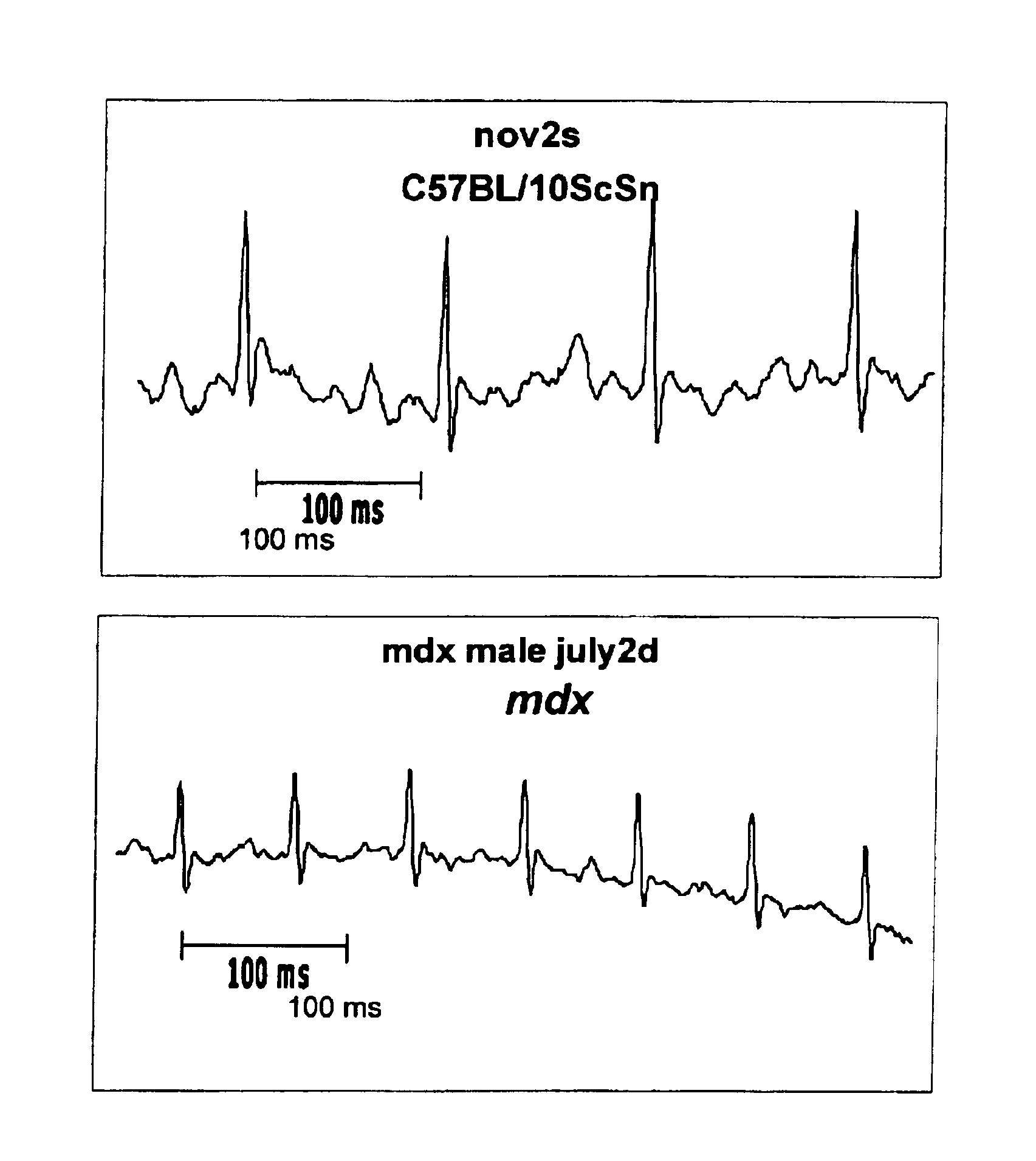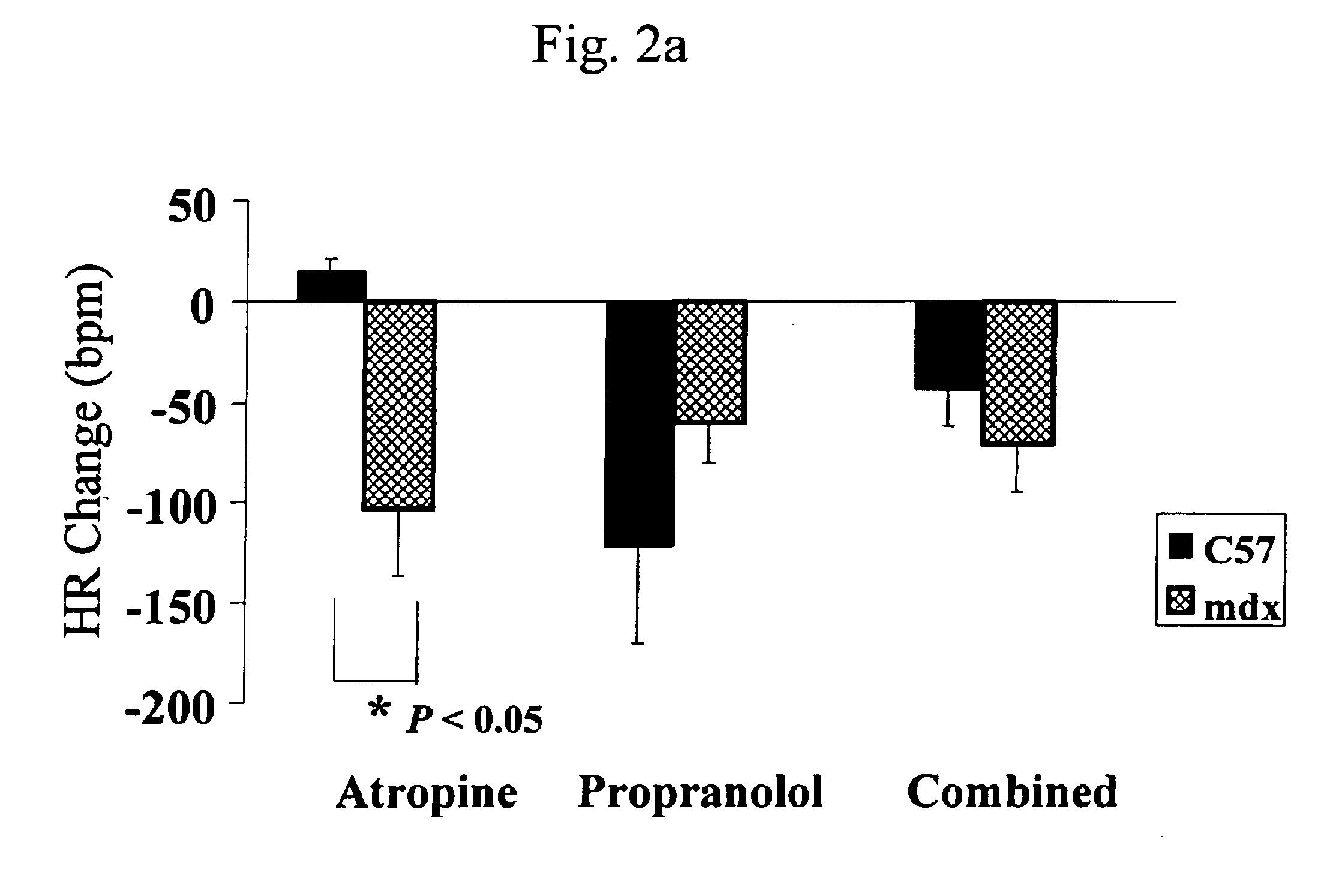Method of early detection of Duchenne muscular dystrophy and other neuromuscular disease
- Summary
- Abstract
- Description
- Claims
- Application Information
AI Technical Summary
Benefits of technology
Problems solved by technology
Method used
Image
Examples
example 1
mdx Mice Lacking Dystrophin Exhibit a Different Baseline HR Dynamics as Compared to Control Mice
The change in heart-rate, heart-rate variability, and the altered autonomic nervous system control of heart-rate modulation were studied in mice deficient in dystrophin (mdx) and in wild-type control mice (C57B). Table 1 summarizes the ECG data in mdx and C57 control mice. At baseline, HR was significantly higher in mdx mice compared to C57 mice. The mdx mice had significantly shorter QRS duration, shorter QT interval, and shorter QTc interval compared to C57 mice. At baseline, PR interval was significantly shorter in mdx mice, and HRV and CV were significantly lower in mdx than C57 mice. FIG. 1 illustrates representative ECG recordings from a C57 control mouse (top panel) and an mdx mouse (bottom panel). Since the mice are conscious and ambulatory, baseline artifact and noise are apparent in the unfiltered signals. Nevertheless, the P wave and T waves are discernible and interpretable by...
example 2
Autonomic Nervous System Blockade
To study the effect of autonomic blockers on dystrophin deficient mice, parasympathetic and sympathetic nervous system control of heart-rate regulation were investigated by pharmacological blockade. Mice received intraperitoneal administration of atropine (0.5 mg / kg) for parasympathetic blockade (n=15 mdx, n=15 C57), propranolol (1 mg / kg) for sympathetic blockade (n=10 mdx, n=7 C57), and atropine (0.5 mg / kg) plus propranolol (1 mg / kg) for combined β-adrenergic and muscarinic cholinergic blockade (n=10 mdx, n=7 C57). Baseline ECGs were recorded within 5 min prior to each administration and after a 5-10 min equilibrium phase after drug administration to allow for HR stabilization. The pharmacological interventions were performed on different days to prevent interference between drugs. Compared to the effects in C57 mice, atropine administration in mdx mice led to significantly greater changes in HR (−90±14 bpm vs. +21±12 bpm, P<0.05) and significa...
example 3
Baroreflex Pressor Response
The HR response to phenylephrine in C57 (n=7) and mdx mice (n=10) were examined. Mice were administered intraperitoneal phenylephrine (3 mg / kg) after β-adrenergic blockade with propranolol (1 mg / kg) to test for a baroreflex-mediated cardio-inhibitory response (n=10 mdx, n=7 C57). After baseline recordings, ECGs were recorded after a 5-10 min equilibrium phase following propranolol administration to allow for HR stabilization, and then within 2 min following phenylephrine administration. Changes in ECG indices following phenylephrine were determined relative to those recorded following propranolol administration.
The pressor challenge was performed after β-adrenergic blockade so that an observed change in HR or HRV could be attributed to activation of the inhibitory limb of the baroreflex and not the result of sympathetic withdrawal. As shown in FIGS. 3a and 3b, mdx mice administered phenylephrine demonstrated significantly smaller reductions in HR and simil...
PUM
 Login to View More
Login to View More Abstract
Description
Claims
Application Information
 Login to View More
Login to View More - R&D
- Intellectual Property
- Life Sciences
- Materials
- Tech Scout
- Unparalleled Data Quality
- Higher Quality Content
- 60% Fewer Hallucinations
Browse by: Latest US Patents, China's latest patents, Technical Efficacy Thesaurus, Application Domain, Technology Topic, Popular Technical Reports.
© 2025 PatSnap. All rights reserved.Legal|Privacy policy|Modern Slavery Act Transparency Statement|Sitemap|About US| Contact US: help@patsnap.com



